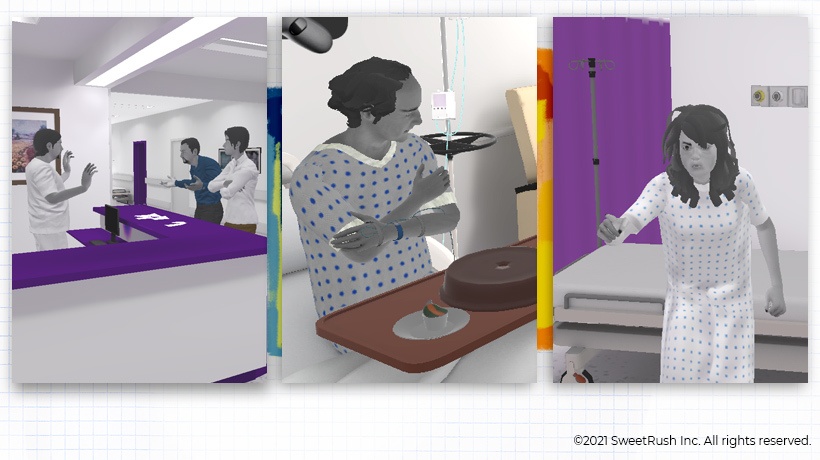Tell a Story Your Most Literal Learners Will Love
You’re sold on the value of creative storytelling and scenario-based learning.
You know that sending your learners on quests and engaging their emotions makes learning content engaging, memorable, and actionable—what we call “sticky.”[1]
You might have experimented with storytelling in some of your eLearning courses—even a whole curriculum. And your learners are responding with five-star reviews.
At least, most of them are.
So why is that small but vocal group still saying “No thanks” to your narrative flourishes?
The truth is, there will always be a few learners who prefer straight shop talk. This group tends to include folks who make, fix, or sell things for a living: Think engineers, mechanics, technicians, IT professionals, and salespeople.
For these learners, time is money—and they only spend it on the facts. When we ask them about their learning needs (and we should!),[2] they’ll probably say something like “Tell me what I need to know, then let me get back to work.”
Don’t eject these learners from the story circle just yet—you can still engage them in your scenario-based learning experiences. These five tips will help you tell a story even your most fact-focused learners won’t want to put down.

Storytelling for the Literal Learner: Five Tips
1. Cast relatable characters.
To buy into a scenario-based learning experience, your makers, fixers, and sellers need to see and hear themselves in the story. Show your fact-focused learners that you value them by giving them characters they relate to.
The three Rs will help you craft a relatable cast:
Representation
Your learners need to see and hear themselves in the story you’re telling. That means that your characters need to represent a range of skin colors, genders, bodies, and abilities.[3]
If you’ve somehow got a monolithic learner audience, you won’t for much longer! With a BIPOC population of 53% under 40 in the U.S. alone,[4] there’s a good chance that your new hires will boost your team’s diversity. Now is the time to ensure that your learning welcomes them into your story.

Real people
Rather than relying on actors, try casting your characters from the front lines of your business. Fact-focused learners are keenly attuned to authenticity and are more likely to buy into characters who look like real people they’d meet on the job.
Real talk
Authentic characters need to talk the talk. Dialogue that is overly stilted, “fluffy,” or branded rings false—and loses credibility. Let your characters narrate on-the-job issues and solutions using the language, idioms, and degree of formality learners use in real life.[5]
2. Connect cause and effect.
You don’t have to look too hard for a great plotline: We use storytelling whenever we show our learners that A leads to B. Fact-focused learners especially appreciate narratives about new skills and how they play out on the job.
You can raise the stakes with a simulation that places the learner at the center of the story and gives them a mission. Then, start the clock!
Our client-partner, a healthcare provider with hundreds of care sites, had the ultimate high-stakes mission for its learner audience of healthcare workers. Healthcare workers face more than 19,000 physical assaults by stressed patients and their families.[6]
The training need was immediate: Healthcare workers needed to keep themselves and others safe by de-escalating verbal and physical aggression. To give learners a safe space to practice their de-escalation skills, our client-partner chose a virtual reality (VR) learning experience.
The VR learning experience takes place in just three rooms, but it is epic. Learners teleport into a hospital hallway, where they immediately hear shouting. Audio and visual prompts guide them toward their mission: Enter the room and de-escalate the patient.

The moment the learner walks in, the patient begins to verbally abuse them. Learners have a few seconds to apply verbal de-escalation methods to defuse the situation and prevent the patient from becoming physically aggressive.
The connection between cause and effect could not be clearer: Apply the right techniques, and the patient calms down. Apply them incorrectly, and the patient escalates to physical aggression.
Learners must then summon a whole new set of skills: responding with movements that protect themselves and others. Real-time feedback helps them get granular about the moments when their tone of voice and body movements cause the situation to escalate—or de-escalate.
This scenario-based learning experience couldn’t be more hands-on—but learning solutions don’t need to be high-tech to be effective. The key is to give the learner a (figurative) dragon to slay and the skills they need to do it. And that dragon should look a lot like the ones they face every day.
3. Use the hero’s journey.[7]
Your learners are great people. Show them how they can become even better—or make the world a better place—by mastering the new content. Whether they’re making a sale, repairing an engine, or defeating a phishing attempt, learners will relish the chance to save the day.

Our client-partner, a leading financial services company, wanted to invite its new call-center associates to do just that. Associates have a straightforward job: answer any kind of customer question, anytime. That meant new hires needed to be able to locate banking information in the database and share it with the customer—all while building rapport, of course!
It’s a heroic undertaking—and, with our client-partner, we planned a hero’s journey that made the most of it. Together, we landed on a scenario-based onboarding adventure with a plot any gamer could appreciate: Players are dropped into an imaginary land to solve the banking problems of its citizens. In the process, they rack up cash rewards, titles of rank, and signature souvenirs.
As they progress along the hero’s journey, they practice searching the database and try their hand at simulated customer conversations. These conversations require them to use the empathy and active listening they’ll apply on the job to unravel customers’ priorities and banking concerns.
This scenario-based learning experience is a skill drill—but it feels like a trip to the arcade. And learners return from their adventure feeling confident, even celebrated. By transporting learners to a faraway land and giving them a chance to save the day, they learn how to be heroes at home.
4. Use story responsibly.
It’s uncanny: When we have a learning solution we love, we start seeing use cases everywhere. (You might have heard the analogy about the hammer purveyor seeing nails everywhere!)
Storytelling is a great tool, but it’s not the best tool for every job. Overuse can diminish its power—and your learners’ patience.
Scenario-based learning is most effective when we need to teach:
- Robust content, also known as “a lot of stuff”
- Responsiveness to complex situations
- Emotional intelligence and interpersonal skills
- Complex behaviors and attitudes
- Problem-solving
It’s not so effective for content that’s a simple “tell,” e.g., topics that could have been an email.

5. Introduce storytelling gradually.
Got a use case for scenario-based learning?
Don’t start typing “It was a dark and stormy night” just yet.
Help your learners get their feet wet by introducing them to your relatable character(s). A few short videos with characters presenting job hacks or stoking interest in upcoming adventures should do the trick.
After your characters have established some rapport with the audience, create a story that invites your learners to help them solve a problem. Keep it close to home with an authentic on-the-job situation, e.g., engaging aggressive patients or curious banking customers.
When you have robust learning content that warrants a truly epic treatment (See No. 4 for use cases), it’s time for your learners to ramp up to a hero’s journey. The hero might be a character, the learner, or your whole team. Rally them around a cause for a quest that requires them to use their on-the-job skills.
Caveat: Strike emotional highs (and lows) sparingly in your scenario-based learning experiences. Some fact-focused learners feel uncomfortable with—and even manipulated by—learning content that aims for their hearts. All brains and temperaments have their own optimal level of stimulation, and your learners may not feel comfortable “spending” their emotional energy at work.
Write the Sequel to Your Story
Love what narrative can do for your learners? Try extending your story to the way you collaborate, communicate, and care with all of your fellow humans at work.
Our eBook It’s All About Your People!: Embracing Human-Centered Business, Workplace Culture, and Learning Design will show you how to re-create work as a source of resilience and tell a story that includes your entire team.
It’s a curated collection of the best mindsets, practices, and lessons from our two decades together as a human-centered organization—and decade-plus as a fully remote team. Whether you’re a leader, manager, or individual contributor, you’ll find plenty of proven steps you can take today (or anytime!) to be happier and healthier at work.
References
- https://elearningindustry.com/how-creative-storytelling-brings-interactive-scenario-based-learning-experiences-to-life
- https://www.nxtbook.com/nxtbooks/trainingindustry/tiq_20191112/index.php#/p/24
- https://elearningindustry.com/diverse-audience-for-virtual-training-tips-to-improve-inclusivity-and-diversity-in-imagery-and-voice-over
- https://www.brookings.edu/research/all-recent-us-population-growth-comes-from-people-of-color-new-census-estimates-show/
- https://www.sweetrush.com/press-play-5-tips-for-writing-audio-scripts/
- https://business.libertymutual.com/insights/workplace-violence-and-unique-exposures-in-the-healthcare-industry/
- https://www.youtube.com/watch?v=d1Zxt28ff-E


